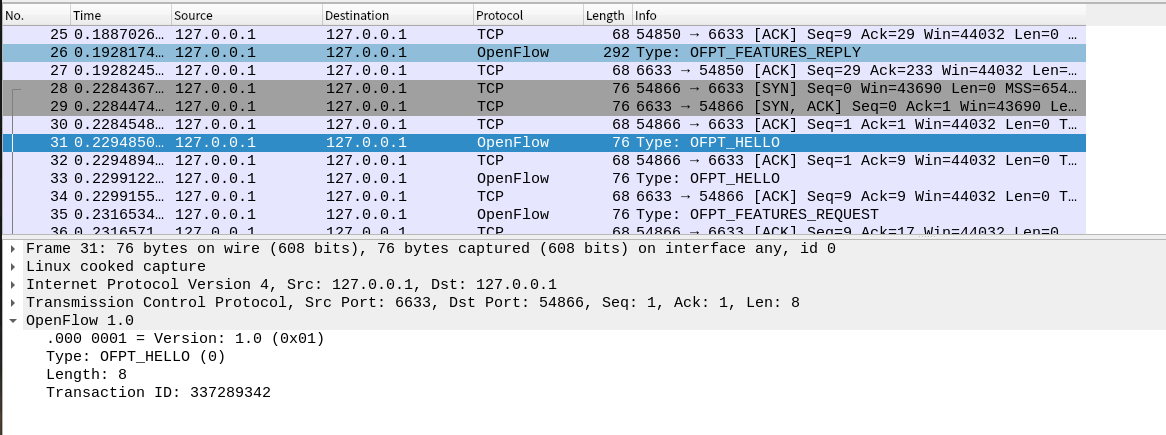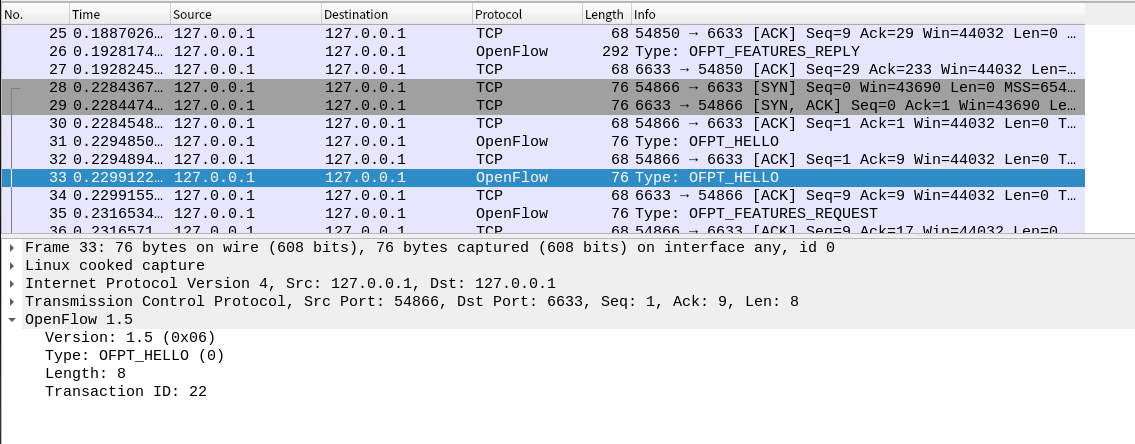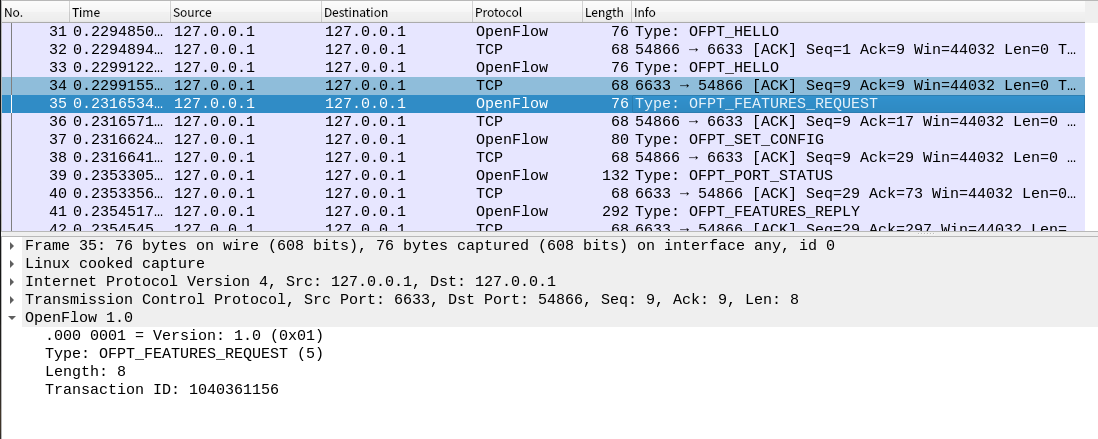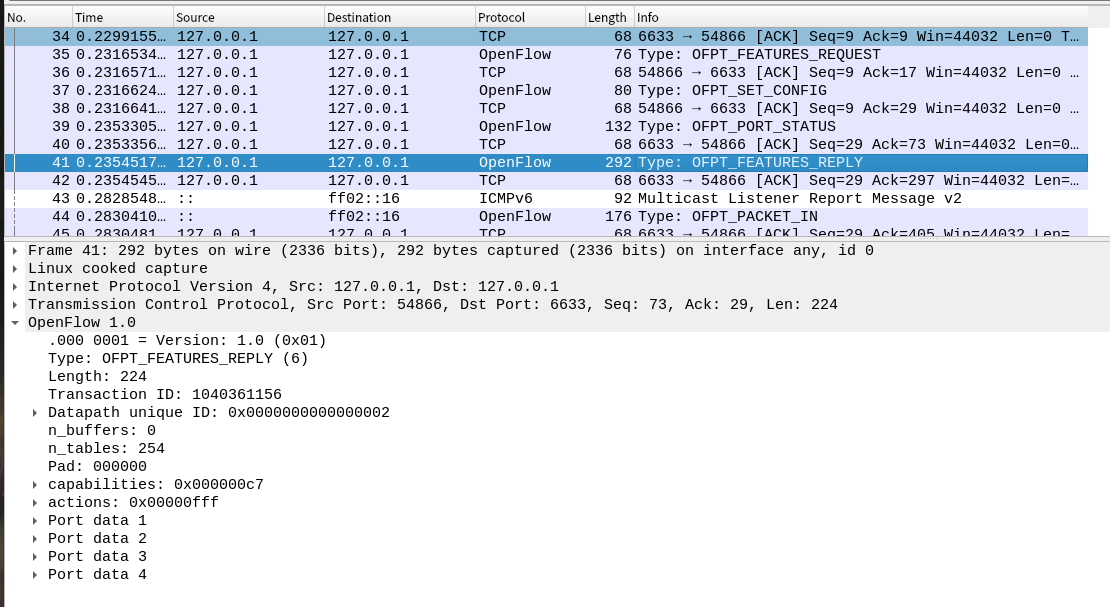实验3:OpenFlow协议分析实践
一、基本要求
1、拓扑文件
#!/usr/bin/env python
from mininet.net import Mininet
from mininet.node import Controller, RemoteController, OVSController
from mininet.node import CPULimitedHost, Host, Node
from mininet.node import OVSKernelSwitch, UserSwitch
from mininet.node import IVSSwitch
from mininet.cli import CLI
from mininet.log import setLogLevel, info
from mininet.link import TCLink, Intf
from subprocess import call
def myNetwork():
net = Mininet( topo=None,
build=False,
ipBase='192.168.0.0/24')
info( '*** Adding controller\n' )
c0=net.addController(name='c0',
controller=Controller,
protocol='tcp',
port=6633)
info( '*** Add switches\n')
s1 = net.addSwitch('s1', cls=OVSKernelSwitch)
s2 = net.addSwitch('s2', cls=OVSKernelSwitch)
info( '*** Add hosts\n')
h1 = net.addHost('h1', cls=Host, ip='192.168.0.101', defaultRoute=None)
h2 = net.addHost('h2', cls=Host, ip='192.168.0.102', defaultRoute=None)
h3 = net.addHost('h3', cls=Host, ip='192.168.0.103', defaultRoute=None)
h4 = net.addHost('h4', cls=Host, ip='192.168.0.104', defaultRoute=None)
info( '*** Add links\n')
net.addLink(h1, s1)
net.addLink(h3, s1)
net.addLink(s1, s2)
net.addLink(s2, h2)
net.addLink(s2, h4)
info( '*** Starting network\n')
net.build()
info( '*** Starting controllers\n')
for controller in net.controllers:
controller.start()
info( '*** Starting switches\n')
net.get('s1').start([c0])
net.get('s2').start([c0])
info( '*** Post configure switches and hosts\n')
CLI(net)
net.stop()
if __name__ == '__main__':
setLogLevel( 'info' )
myNetwork()
2、wireshark抓包的结果截图
- hello控制器6633端口(我最高能支持OpenFlow 1.0) ---> 交换机54866端口
![]()
- hello交换机54866端口(我最高能支持OpenFlow 1.5) ---> 控制器6633端口
![]()
- 于是双方建立连接,并使用OpenFlow 1.0
- Features Request控制器6633端口(我需要你的特征信息) ---> 交换机54866端口
![]()
- Set Conig控制器6633端口(请按照我给你的flag和max bytes of packet进行配置) ---> 交换机54866端口
![]()
- Port_Status当交换机端口发生变化时,告知控制器相应的端口状态。
![]()
- Features Reply交换机54866端口(这是我的特征信息,请查收) ---> 控制器6633端口
![]()
- Packet_in交换机54866端口(有数据包进来,请指示)--- 控制器6633端口
![]()
- Packet_out控制器6633端口(请按照我给你的action进行处理) ---> 交换机54866端口
![]()
- Flow_mod分析抓取的flow_mod数据包,控制器通过6633端口向交换机54866端口、交换机54866端口下发流表项,指导数据的转发处理
![]()
- 画出相关交互图或流程图
![]()
- 回答问题:交换机与控制器建立通信时是使用TCP协议还是UDP协议
答:TCP协议
二、进阶要求
将抓包基础要求第2步的抓包结果对照OpenFlow源码
- hello控制器6633端口(我最高能支持OpenFlow 1.0) ---> 交换机54866端口
![]()
struct ofp_header {
uint8_t version; /* OFP_VERSION. */
uint8_t type; /* One of the OFPT_ constants. */
uint16_t length; /* Length including this ofp_header. */
uint32_t xid; /* Transaction id associated with this packet.
Replies use the same id as was in the request
to facilitate pairing. */
};
struct ofp_hello {
struct ofp_header header;
};
-
hello交换机54866端口(我最高能支持OpenFlow 1.5) ---> 控制器6633端口
![]()
-
Features Request控制器6633端口(我需要你的特征信息) ---> 交换机54866端口
![]()
struct ofp_header {
uint8_t version; /* OFP_VERSION. */
uint8_t type; /* One of the OFPT_ constants. */
uint16_t length; /* Length including this ofp_header. */
uint32_t xid; /* Transaction id associated with this packet.
Replies use the same id as was in the request
to facilitate pairing. */
};
struct ofp_hello {
struct ofp_header header;
};
- Set Conig控制器6633端口(请按照我给你的flag和max bytes of packet进行配置) ---> 交换机54866端口
![]()
struct ofp_switch_config {
struct ofp_header header;
uint16_t flags; /* OFPC_* flags. */
uint16_t miss_send_len; /* Max bytes of new flow that datapath should
send to the controller. */
};
- Port_Status当交换机端口发生变化时,告知控制器相应的端口状态。
![]()
struct ofp_port_status {
struct ofp_header header;
uint8_t reason; /* One of OFPPR_*. */
uint8_t pad[7]; /* Align to 64-bits. */
struct ofp_phy_port desc;
};
- Features Reply交换机54866端口(这是我的特征信息,请查收) ---> 控制器6633端口
![]()
struct ofp_phy_port {
uint16_t port_no;
uint8_t hw_addr[OFP_ETH_ALEN];
char name[OFP_MAX_PORT_NAME_LEN]; /* Null-terminated */
uint32_t config; /* Bitmap of OFPPC_* flags. */
uint32_t state; /* Bitmap of OFPPS_* flags. */
/* Bitmaps of OFPPF_* that describe features. All bits zeroed if
* unsupported or unavailable. */
uint32_t curr; /* Current features. */
uint32_t advertised; /* Features being advertised by the port. */
uint32_t supported; /* Features supported by the port. */
uint32_t peer; /* Features advertised by peer. */
};
struct ofp_switch_features {
struct ofp_header header;
uint64_t datapath_id; /* Datapath unique ID. The lower 48-bits are for
a MAC address, while the upper 16-bits are
implementer-defined. */
uint32_t n_buffers; /* Max packets buffered at once. */
uint8_t n_tables; /* Number of tables supported by datapath. */
uint8_t pad[3]; /* Align to 64-bits. */
/* Features. */
uint32_t capabilities; /* Bitmap of support "ofp_capabilities". */
uint32_t actions; /* Bitmap of supported "ofp_action_type"s. */
/* Port info.*/
struct ofp_phy_port ports[0]; /* Port definitions. The number of ports
is inferred from the length field in
the header. */
};
- Packet_in交换机54866端口(有数据包进来,请指示)--- 控制器6633端口
![]()
enum ofp_packet_in_reason {
OFPR_NO_MATCH, /* No matching flow. */
OFPR_ACTION /* Action explicitly output to controller. */
};
struct ofp_packet_in {
struct ofp_header header;
uint32_t buffer_id; /* ID assigned by datapath. */
uint16_t total_len; /* Full length of frame. */
uint16_t in_port; /* Port on which frame was received. */
uint8_t reason; /* Reason packet is being sent (one of OFPR_*) */
uint8_t pad;
uint8_t data[0]; /* Ethernet frame, halfway through 32-bit word,
so the IP header is 32-bit aligned. The
amount of data is inferred from the length
field in the header. Because of padding,
offsetof(struct ofp_packet_in, data) ==
sizeof(struct ofp_packet_in) - 2. */
};
- Packet_out控制器6633端口(请按照我给你的action进行处理) ---> 交换机54866端口
![]()
struct ofp_action_header {
uint16_t type; /* One of OFPAT_*. */
uint16_t len; /* Length of action, including this
header. This is the length of action,
including any padding to make it
64-bit aligned. */
uint8_t pad[4];
};
struct ofp_packet_out {
struct ofp_header header;
uint32_t buffer_id; /* ID assigned by datapath (-1 if none). */
uint16_t in_port; /* Packet's input port (OFPP_NONE if none). */
uint16_t actions_len; /* Size of action array in bytes. */
struct ofp_action_header actions[0]; /* Actions. */
/* uint8_t data[0]; */ /* Packet data. The length is inferred
from the length field in the header.
(Only meaningful if buffer_id == -1.) */
};
- Flow_mod分析抓取的flow_mod数据包,控制器通过6633端口向交换机54866端口、交换机54866端口下发流表项,指导数据的转发处理
![]()
struct ofp_flow_mod {
struct ofp_header header;
struct ofp_match match; /* Fields to match */
uint64_t cookie; /* Opaque controller-issued identifier. */
/* Flow actions. */
uint16_t command; /* One of OFPFC_*. */
uint16_t idle_timeout; /* Idle time before discarding (seconds). */
uint16_t hard_timeout; /* Max time before discarding (seconds). */
uint16_t priority; /* Priority level of flow entry. */
uint32_t buffer_id; /* Buffered packet to apply to (or -1).
Not meaningful for OFPFC_DELETE*. */
uint16_t out_port; /* For OFPFC_DELETE* commands, require
matching entries to include this as an
output port. A value of OFPP_NONE
indicates no restriction. */
uint16_t flags; /* One of OFPFF_*. */
struct ofp_action_header actions[0]; /* The action length is inferred
from the length field in the
header. */
};
struct ofp_action_header {
uint16_t type; /* One of OFPAT_*. */
uint16_t len; /* Length of action, including this
header. This is the length of action,
including any padding to make it
64-bit aligned. */
uint8_t pad[4];
};
struct ofp_match {
uint32_t wildcards; /* Wildcard fields. */
uint16_t in_port; /* Input switch port. */
uint8_t dl_src[OFP_ETH_ALEN]; /* Ethernet source address. */
uint8_t dl_dst[OFP_ETH_ALEN]; /* Ethernet destination address. */
uint16_t dl_vlan; /* Input VLAN id. */
uint8_t dl_vlan_pcp; /* Input VLAN priority. */
uint8_t pad1[1]; /* Align to 64-bits */
uint16_t dl_type; /* Ethernet frame type. */
uint8_t nw_tos; /* IP ToS (actually DSCP field, 6 bits). */
uint8_t nw_proto; /* IP protocol or lower 8 bits of
* ARP opcode. */
uint8_t pad2[2]; /* Align to 64-bits */
uint32_t nw_src; /* IP source address. */
uint32_t nw_dst; /* IP destination address. */
uint16_t tp_src; /* TCP/UDP source port. */
uint16_t tp_dst; /* TCP/UDP destination port. */
};
三、个人总结
本次实验难度相较之前的实验难度提升不大,但是更为繁琐,需要仔细地去寻找取控制器与交换机之间的通信数据包。
一开始,我看见老师的PDF中提到先开启抓包再构建拓扑,以为是先打开mininet的CLI连接,再打开wireshark抓包,最后pingall,结果发现,找不到hello的包。后经发现,是先打开wireshark抓包,再做mininet的CLI连接和pingall。在pingall之后,才会有Flow_mod的包。
在做进阶要求时,我在头文件中找不到Features Request的相关说明,在经过询问同学之后,才发现Features Request的结构体的四个数据类型与HELLO的完全相同。











 浙公网安备 33010602011771号
浙公网安备 33010602011771号